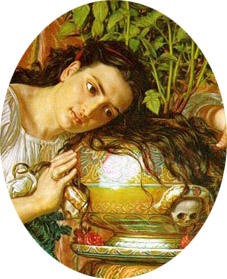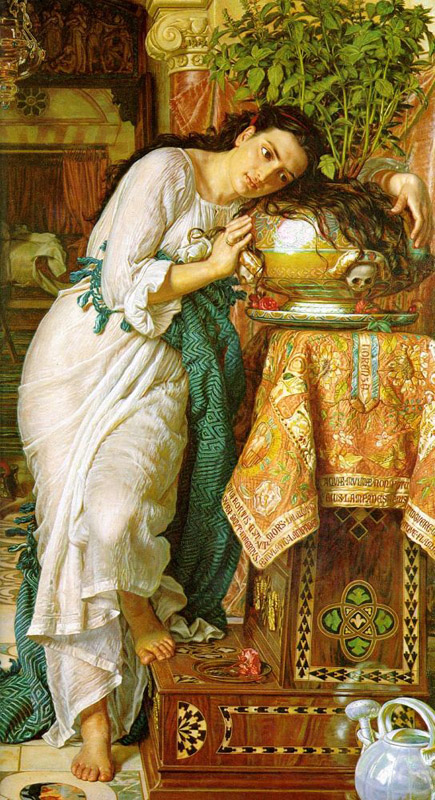An important hallmark of Pre-Raphaelite art is truth to nature. Of course, there are many reasons why the art of the Pre-Raphaelites is so visually striking. Their subject matter often illustrates a compelling narrative, the vibrant hues they used results in a visually arresting effect that commands attention, and who can resist the beauty of a long-haired Pre-Raphaelite Stunner?
For this post, though, I’d like to focus on the works that stand out to me as excellent examples of botanical precision.
This is entirely subjective, of course, and if you’d like to suggest a painting you feel I’ve overlooked I welcome your comments.
Ophelia, Sir John Everett Millais
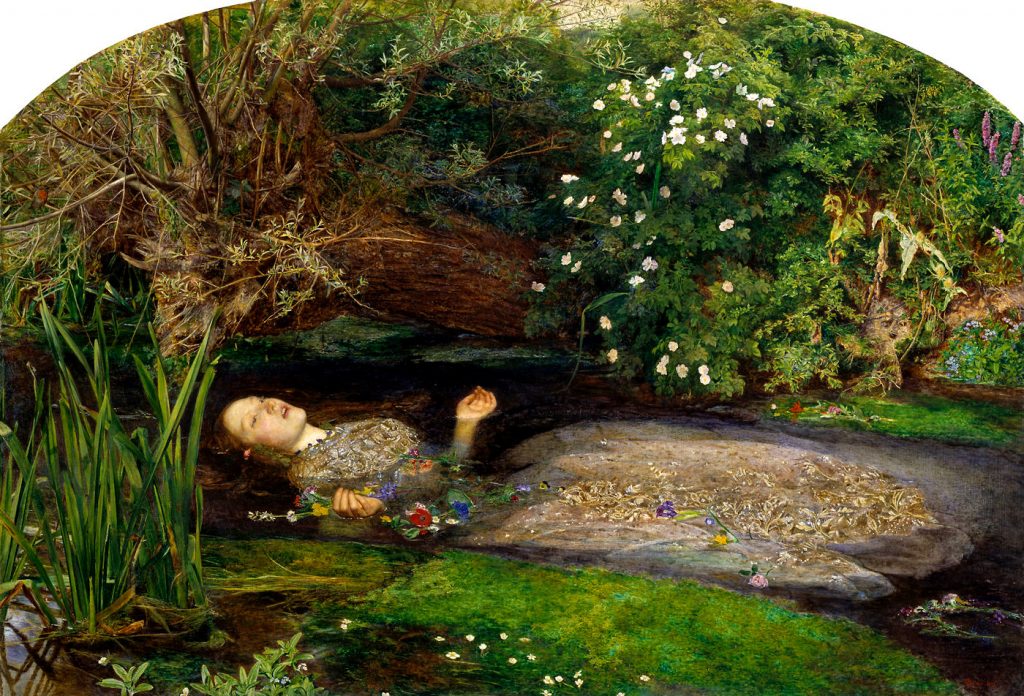
Ophelia may very well be Sir John Everett Millais’ most widely recognized picture. The story behind it is a famous one, model Elizabeth Siddal became quite ill after posing in a bathtub while wearing an antique gown.
You can read more about her uncomfortable experience posing for the painting on the Ophelia page of my site LizzieSiddal.com. Millais set up a series of oil lamps under a bathtub in order to keep the water at a comfortable temperature. The lamps did not last, however, and Siddal posed for hours in the cold, never saying a word. This led to illness and the threat of a lawsuit from her father. Siddal later married fellow Pre-Raphaelite artist Dante Gabriel Rossetti in 1860; she died of a laudanum overdose two years after their marriage.
When John Everett Millais painted Ophelia he chose to depict her in the moments just before she drowns. In the midst of this picture of death, the plant life is rich and colorful. Each plant, whether in background or foreground, is given equal attention and no detail is spared. The botanical aspects of Ophelia are so important that Millais labored meticulously on the background.
Throughout Hamlet, Ophelia is constantly mistreated and used. Prior to the action of the play, Hamlet and Ophelia are in love. After seeing his father’s ghost, Hamlet decides to distance himself from her as he plots revenge for his father’s murder. When Hamlet kills Ophelia’s father, Polonius, she loses her sanity. Even though she appears quite mad, the flowers she gives to the King, Queen and Laertes have pointed meanings that would have been obvious to Shakespeare’s audience.
Ophelia: “There’s rosemary, that’s for remembrance; pray you, love, remember: and there is pansies, that’s for thoughts.”
Laertes: “A document in madness,–thought and remembrance fitted.”
Ophelia: “There’s fennel for you, and columbines:–there’s rue for you; and here’s some for me:–we may call it herb-grace o’Sundays:–O you must wear your rue with a difference.–There’s a daisy:–I would give you some violets, but they wither’d all when my father died:–they say he made a good end. ” [Sings] “For bonny sweet Robin is all my joy–“
The scene contains no stage direction, but it is generally accepted that Ophelia hands the flowers out.
To her brother Laertes, rosemary and pansies. For remembrance and thought, both of which are probably alluding to their slain father.
To King Claudius, fennel and columbines. Fennel for flattery. Columbine may mean ingratitude. Fennel was also believed to cast away evil spirits. Perhaps Ophelia was suggesting that Claudius was evil.
To Queen Gertrude, rue and daisy. Rue for repentance. Is the queen to wear hers with a difference because she shows no repentance for her previous husband’s death? Daisy for faithlessness. See Ophelia’s End: Does She Hand Out the Flowers?
In addition to the flowers mentioned in Hamlet, Millais added other flowers with symbolic meaning. Forget-me-nots are visible on the bank. A red poppy floats near Ophelia’s hand, a symbol of sleep and death. Despite her saying that there were no violets, we can see she wears a necklace of them. Fritillary, symbols of sorrow, also appear.
In Act 4, Scene 5 we hear Queen Gertrude’s description of Ophelia’s death. Again, plants play an important role.
QUEEN GERTRUDE: There is a willow grows aslant a brook,
That shows his hoar leaves in the glassy stream;
There with fantastic garlands did she come
Of crow-flowers, nettles, daisies, and long purples
That liberal shepherds give a grosser name,
But our cold maids do dead men’s fingers call them:
There, on the pendent boughs her coronet weeds
Clambering to hang, an envious sliver broke;
When down her weedy trophies and herself
Fell in the weeping brook. Her clothes spread wide;
And, mermaid-like, awhile they bore her up:
Which time she chanted snatches of old tunes;
As one incapable of her own distress,
Or like a creature native and indued
Unto that element: but long it could not be
Till that her garments, heavy with their drink,
Pull’d the poor wretch from her melodious lay
To muddy death.
And so Ophelia dies, alone with her flowers.
Gertrude describes her as ‘mermaid like’ as if in an attempt to beautify the ugliness of death.
Isabella and the Pot of Basil, William Holman Hunt
Isabella is an example of absorbing, haunting grief and is based on the narrative poem by John Keats.
Isabella, the daughter of an affluent family, is in love with one of their servants, Lorenzo. Her brothers, having planned for Isabella to make a financially advantageous marriage, decide that swift action must be taken to stop Lorenzo and Isabella.
They murder Lorenzo.
His ghost later appears to Isabella and he leads her to his buried body. She digs him up, removes his head, and buries it in a pot of basil.
She then cares for the pot of basil obsessively, pining away and consumed with despair.
Hunt’s painting is brilliant in the way that he contrasts life and death. Her hair mingles with the leaves of the basil plant, a plant that is thriving due to her lover’s decomposing head. It’s incredibly macabre and sad.
Sadder still is the fact that Hunt used his own wife, heavily pregnant at the time, as the model for Isabella. She died a few months later, leaving Hunt a widower with a baby to care for.
One thing that draws me to Pre-Raphaelite art is this juxtaposition of something ugly with something beautiful.
Grief, death, sorrow are shown through gorgeous imagery and jewel-like tones. The notion that Isabella has severed her deceased lover’s head in order to keep him close is something that we should find disturbing. Yet when looking at artistic depictions of Isabella, we are not repulsed. It is the haunting beauty and sadness we see and not the gruesome nature of her act.
And she forgot the stars, the moon, and sun, And she forgot the blue above the trees, And she forgot the dells where waters run, And she forgot the chilly autumn breeze; She had no knowledge when the day was done, And the new morn she saw not: but in peace Hung over her sweet Basil evermore, And moisten’d it with tears unto the core ––John Keats
Autumn Leaves, Sir John Everett Millais
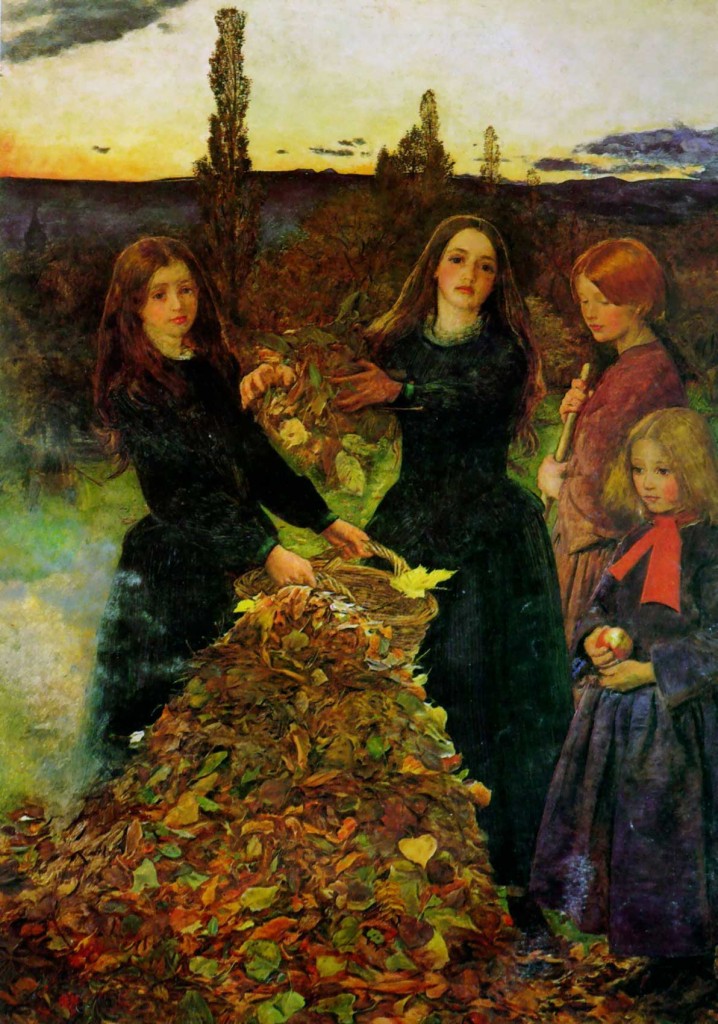
Autumn Leaves is an impressive example of a Pre-Raphaelite twilight.
The models for this work included Millais’ sisters-in-law Alice and Sophie Gray, a Miss Smythe of Methven, and an unidentified local girl, according to the artist’s son in The Life and Letters of Sir John Everett Millais.
The pile of leaves is itself a mass of intricate detail, with each leaf painted with precision and in a variety of shades. Anyone who has ever plunged into a pile of leaves as a child should be able to appreciate this work.
That it was highly appreciated by Mr. Ruskin may be gathered from the Academy Notes, 1856, in which he refers to it as “by much the most poetical work the painter has yet conceived; and also, so far as I know, the first instance of a perfectly painted twilight. It is easy, as it is common, to give obscurity to twilight, but to give within its darkness is another matter; and though Giorgione might have come nearer the glow, he never gave the valley mist. Note also the subtle difference between the purple of the long nearer range of hills and the blue of the distant peak.” –The Life and Letters of Sir John Everett Millais
John Ruskin’s description of Autumn Leaves above dates from 1856, and he should be lauded for writing so objectively about Millais’ work considering that it was not too long after Ruskin’s wife Effie left their marriage in order to marry Millais. This dramatic affair is mentioned quite often when discussing scandalous relationships among the Pre-Raphaelites (see Pre-Raphaelite Marriages: Ruskin, Effie and Millais and Playing Ruskin’s Advocate).
Three Women Plucking Mandrakes, Robert Bateman
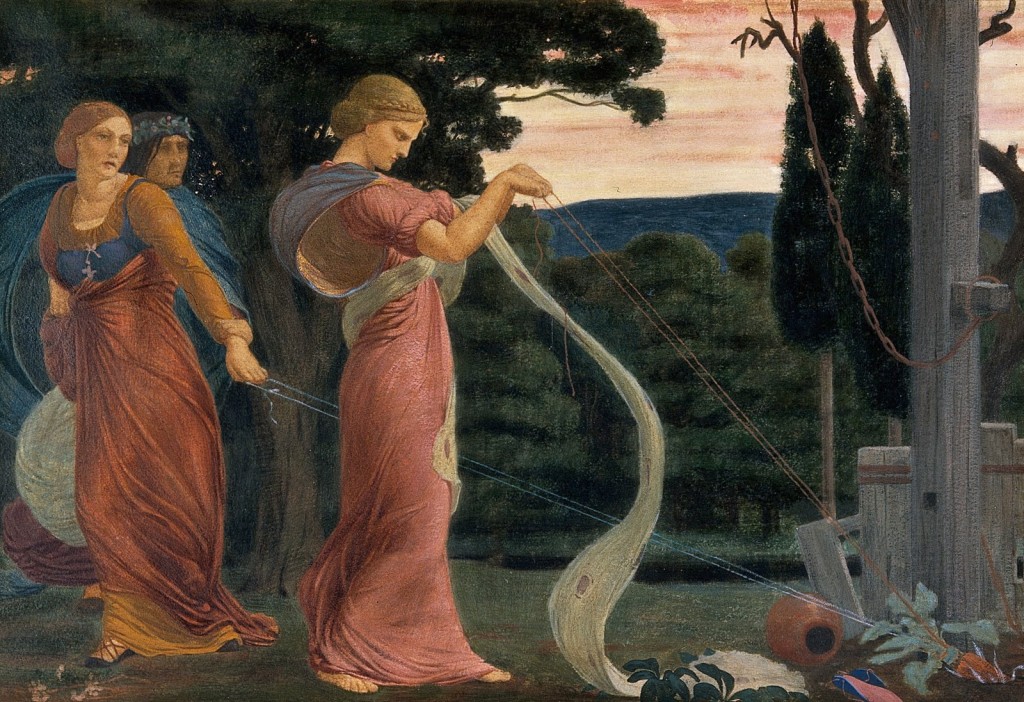
Robert Bateman was not a member of the Pre-Raphaelite Brotherhood, but he definitely emulated their style. Nigel Daly recently wrote a fascinating book, The Lost Pre-Raphaelite: The Secret Life and Loves of Robert Bateman in 2014 after moving into and restoring Bateman’s former home.
Three Women Plucking Mandrakes does not have the same level of botanical precision as many other Pre-Raphaelite works, but I love it because of its folkloric associations.
Mandrake can be found in a wide variety of ancient literature from the Bible to magical lore and was used as an anaesthetic or to treat mania. Large quantities could induce madness. The mandrake’s appearance makes it a perfect plant for fairy tales and it is now recognized by an entire generation of Harry Potter fans.
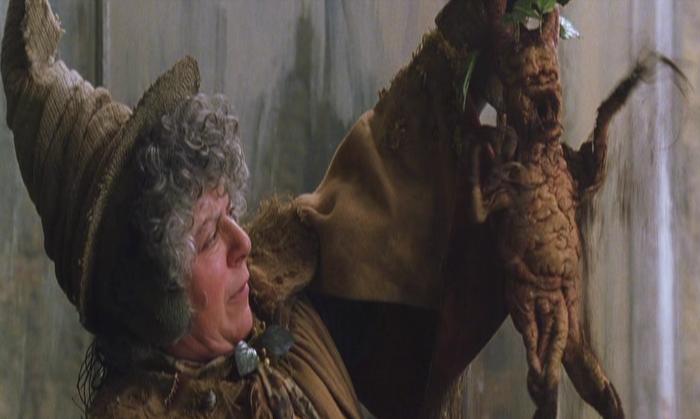
Flora, Evelyn De Morgan
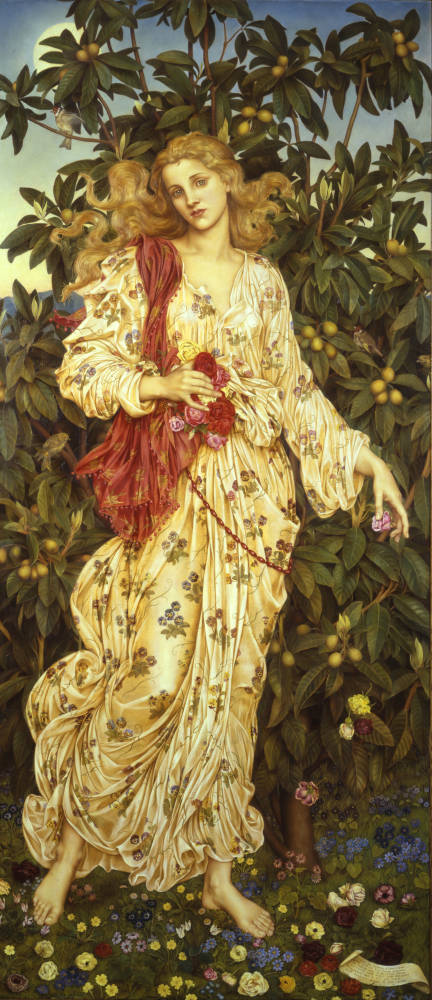
De Morgan’s Flora is inspired by both Botticelli’s Primavera and The Birth of Venus, works that are similar to each other while each being iconic in their own right. The stance in De Morgan’s Flora seems straight from Venus in her shell. Her gown is also similar to Flora’s gown in Primavera. Flora may be an amalgam of Botticelli works, but she still seems original and fresh as a completely De Morgan piece. And unlike Botticelli’s works, De Morgan shows Flora without any figures surrounding her. Flora stands alone, allowing her to be the sole focus of the painting.
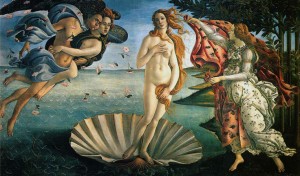
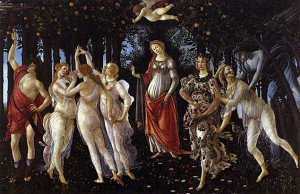
De Morgan and her husband, the ceramicist William De Morgan, spent a great deal of time in Florence and there she developed a love for Italian art that shines through her works. Her paintings are often compared to those of Sir Edward Burne-Jones, which is an apt comparison. They both excel at drapery and creating uniquely beautiful women. Art was in her blood, it seems. Her uncle was the artist John Roddam Spencer Stanhope, who also served as her teacher. It is important to note that while she studied under Stanhope and is compared to Burne-Jones, De Morgan’s work is not derivative. She has a unique and definitive style.
Perdita, Frederick Sandys
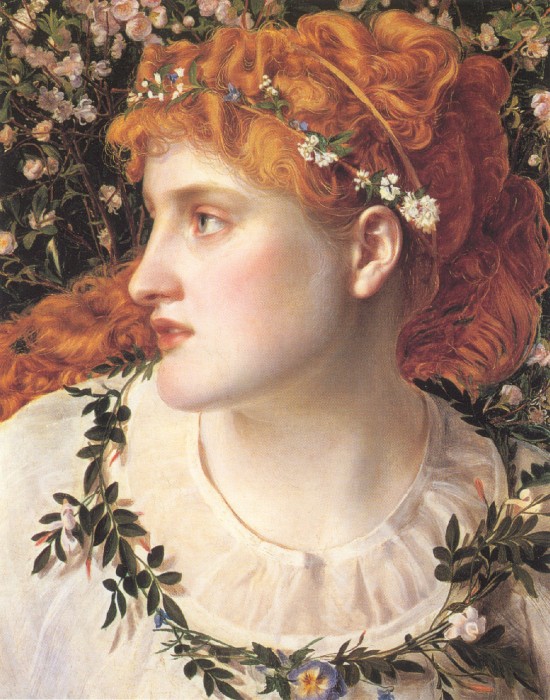
In Perdita by Frederick Sandys, I see the influence of both Botticelli and Dante Gabriel Rossetti. I’ve explored the painting more fully in the post Perdita, the lost girl, which also explains the Shakespearean roots of the character (as well as a certain famous Dalmatian). You can see in the garland around her head and neck and in the flowers behind her that Sandys put a great deal of effort into recreating the blossoms with fidelity.
La Ghirlandata, Dante Gabriel Rossetti
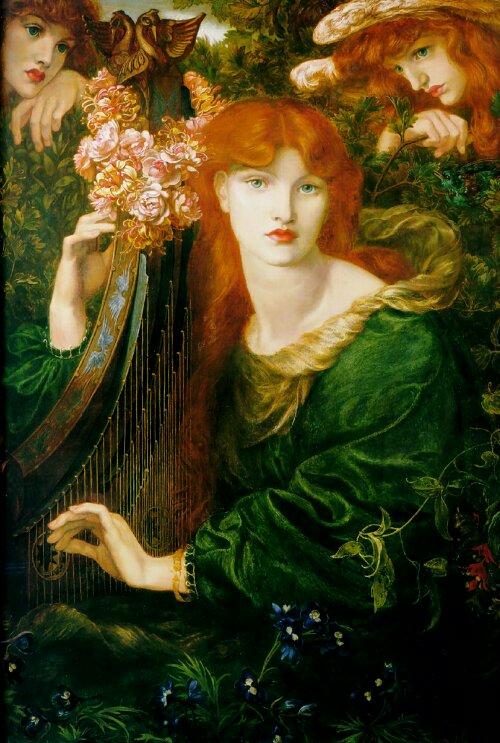
La Ghirlandata translates into The Lady of the Wreath or Garland, a fitting title as she is surrounded by foliage. The artist’s brother, William Michael Rossetti, mentions that the flowers in the painting may have been a mistake:
The flowers which are prominent in the picture were intended by my brother for the poisonous monkshood: I believe he made a mistake, and depicted larkspur instead. I never heard him explain the underlying significance of this picture: I suppose he purposed to indicate, more or less, youth, beauty, and the faculty for art worthy of a celestial audience, all shadowed by mortal doom.
La Ghirlandata was painted at Kelmscott Manor after a period of great difficulty for Rossetti — he had attempted suicide earlier that year. Despite his paranoia and mental troubles, his work during this period is vibrant and beautiful. This painting,in particular, is appealing to me with its stunning contrast of glorious red hair and verdant green which made it an ideal choice to grace the cover of Red: A History of the Redhead. It also appears on Mortal Love by Elizabeth Hand, a swirling epic that I highly recommend. The main figure in this piece is Alexa Wilding, a model Rossetti used frequently in his later years. The angels were modeled by May, the ten-year-old daughter of Jane and William Morris. Both models have been recreated in the ideal Rossetti physical form, those distinctive lips alone tell you that this piece sprung from the soul of Dante Gabriel Rossetti.
Little is known about Alexa Wilding, but you may enjoy A Curl of Copper and Pearl by Kirsty Stonell Walker. Kirsty has assembled the bare bones of Alexa’s life and fleshed them out into a fascinating and compelling work of fiction. Much like Rossetti did when he exaggerated her features on canvas, Kirsty skillfully paints a picture of young Alice (later Alexa) Wilding as Rossetti discovered her on the street and transforms her life of drudgery into one of art and beauty.
Here’s a brief synopsis of the painting, courtesy of City of London:
“Rossetti painted this picture while he was staying at Kelmscott Manor, the Oxfordshire house he part-owned with his friend William Morris, following his breakdown and suicide attempt in 1872. Morris stayed away, but his wife Jane – with whom Rossetti was in love – was there. The honeysuckle and roses around the top of the harp in this picture indicate sexual attraction, while the harp itself represents music – a common metaphor for love and lovemaking. However the model for the picture was not Jane Morris but a model, Alexa Wilding, ‘a really good-natured creature’, who arrived at Kelmscott in June 1873.
The angel heads at the top were painted from Jane’s ten-year-old daughter May, who was said to dislike Alexa intensely. La Ghirlandata is one of several paintings of women playing musical instruments which Rossetti painted between 1871 and 1874. His intense use of colour creates a brooding, melancholy mood, while the picture’s symbolism – though unclear – may reflect his emotional condition at this time.”
Rossetti’s chalk version of La Ghirlandata was given to Charles Augustus Howell for payment of a debt. The drawing is currently owned by Lord Andrew Lloyd-Webber, familiar to most of us as the composer of Phantom of the Opera, Cats, Evita and more. Lloyd-Webber owns a great deal of Pre-Raphaelite art and in 2003, the Royal Academy held an exhibition featuring his collection in Pre-Raphaelite and Other Masters – The Andrew Lloyd Webber Collection.
Dante Gabriel Rossetti declared that La Ghirlandata should be ‘the greenest picture in the world’. And who’s to say it isn’t? Rossetti gave us a sea of velvety green to swim in and his bevy of green-clad women are just a part of the reason I love Pre-Raphaelite art so deeply. Perhaps I am the green girl, inspired by the depth of that particular hue.

